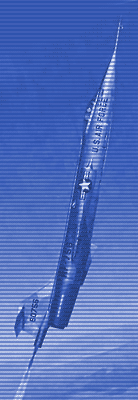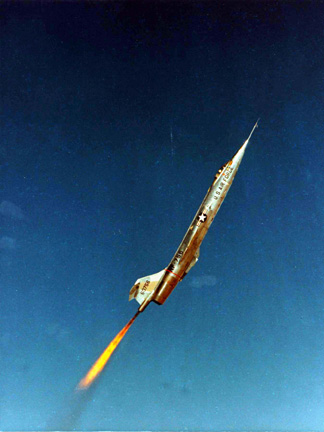The Mission > home

|
|
|
|
|
|
 |
The Mission click on the links below for more of the story...
|
||
3 Joint Test ProgramTraditionally, the contractor’s pilots flew these with a smaller share by the Air Force pilots. Usually it was an extended test project. The AST’s contractor testing was traditional in principal but very limited in scope and duration, less than 4 months, which addressed only the peculiar systems and performance ranges of it. The first flight in the JTP was flown on 9 July 1963 and the last on 24 October 1963. The austerity of the project was especially evident in this and even more truncated in the ensuing Air Force testing. Jack Woodman was responsible for this testing at their factory located on Palmdale Airport until the aircraft were accepted for delivery by the Air Force, with me flying a limited share. The plan was to demonstrate the normal flight performance of the AST, compared to a F-104 fighter on one AST. Then expand the AST’s design envelope to the maximum zoom mission on a second bird. Upon satisfactory performance and acceptance of the project, I would fly the airplanes to Edwards and expand the envelope and fully qualify the AST for training operations, during the Air Force testing, before turnover to ARPS.
The dynamics testing on the first airplane (#60756) involved 18 flights to check critical stability points of the AST remained generally within the normal F-104 operating regimes. This was deemed an acceptable trade against cost of a major test program, to correlate AST performance to all existing data from the extensive F-104 flight tests. Jack flew first on July 9 1963 and these tests topped out at Mach 2.2 with full rocket motor thrust, in level flight. I flew a couple of them to get a feel for the airplane. The maneuvering was limited, because pulling g’s diminished dynamic stability at high Mach number, and loss of dynamic stability under such conditions is a one time experience, fatality being the probable outcome. The test point did provide some margin, nevertheless. I would later expand my tests to reduce this restriction. Concurrently, we both flew the unique AST performance, and envelope expansion tests on the second aircraft (#60760). He made the usual initial functional test flight on 10 Aug, including stalls to compare with the standard airplane. Thus began a series of dynamic stability flights, at increasing Mach numbers and attitude variations. I made my initial AST flight in this airplane, its fourth flight, Mach 2 stability test on the way to the planned limit of 2.2 mach at 3.5 g, for maximum performance missions. Jack began functional testing of the unique systems on the reaction controls (RCS) on its 3rd test flight, though not very definitive until using it in full performance. He fired the liquid rocket motor on its 4th. I flew this aircraft next; my first use of the RCS thrusters and liquid rocket. The thrusters maintained impulse for the duration of the commanded input, but with the airspeed in the atmosphere had minor, temporary effect on the airplanes motion, which was to be expected. These thrusters would be the sole means of control when zoom flights exceeded the limits of aerodynamics, and only on that first and critical maximum performance zoom, would we be certain. I was surprised with the smooth but significant acceleration of the rocket motor, which felt like a perfect fluid drive, compared with the jolt when lighting an afterburner. The smooth increase of thrust in the controllable range of 50 to 100% of rocket thrust was noticeable but proved to be of little use during a maximum zoom maneuver, where, not only jet and afterburner were 100%, but the rocket, even at light-off, was “throttle to the wall”. 23 Sept, Jack’s 19th flight, he flew the first AST low zoom and topped out at 89,600 feet, intentionally climbing at a much lower angle than the theoretical optimum angle of 70-degrees. I made my first zoom, my fourth AST flight, two days later. Climbing at a low angle, about 40-degrees, I reached 88,000 feet, not much over my ARPS zooms in a standard 104 but it provided me a chance to use the systems and displays. According to a note in charts of the Woodman biography, I encountered problems with control on this flight, due to incorrect wiring of the RCS system. My memory is vivid of that event and it happened not on this but my succeeding flight, where I will describe it. In fact, it would hardly have been noticeable at this low altitude climb. On the 26th, Jack raised his altitude to 97,500 feet with another increase in climb angle. Starting on 4 October through the 10th, Jack continued gradually increased climb angle zooms to 102,000, 106,000 and 106,500, respectively. These flights were at increased climb angle, but remained within the capability of the airplanes aero flight controls. The zooms were still at high enough dynamic pressure and corresponding low climb angle not to require the RCS to maintain control and assure a safe return. Jack had to abort the first scheduled maximum zoom on the morning of the 21st, due to a malfunction of his pressure suit, an unusual occurrence, unrelated to the airplane. On that same afternoon, Jack made another successful zoom to 109,000 feet, implying to me something less than the maximum climb angle, once again. Jack had wisely been creeping up on the angle, as I expect he was directed to do. |
| previous section | next section |
